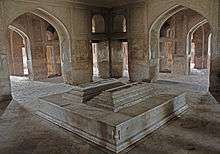Tomb of Nur Jahan


The Tomb of Nur Jahan (Urdu: نور جہاں کا مقبرہ) is a red sandstone mausoleum located in Shahdara Bagh in Lahore, Punjab, Pakistan. It was constructed for the Mughal empress Nur Jahan as her final resting place.
History
Mehr-un-Nissa(1577-1645), entitled Nur Jahan (Light of the World), was the fourth child of Mirza Ghiyas Beg, a noble from Persia, and of his wife, Asmat Begum. She was born after the family had migrated to India. Her father served the Mughal emperor Akbar, who bestowed him with the title of 'Itmat-ud-daulah' (Pillar of the State), while her brother Asaf Khan served Jahangir and the next heir to the Mughal throne. After she became a widow in 1607, she became the last and favorite consort of Mughal Emperor Jahangir (1569-1627) in 1611.
For the rise from an immigrant to become an Empress of the great Mughal empire, Nur Jahan was one of the most influential women of her era. Nur Jahan's illustrious reign (1611-1627) saw her effectively shape the expanding Mughal Empire, along with her immense contributions to religion and flourishing overseas trade. Mehr-un-Nissa was first married at the age of 17 to a Persian adventurer named Sher Afghan Ali Quli Khan Istajlu, who was renowned for his brilliant military career, and from whom she bore a daughter, Ladli Begum Having survived Jahangir by 18 years, she died at the age of 68 years and the mausoleum was most probably constructed during her lifetime. The mausoleum is located in Shahdara Bagh, not far from the tomb of Jahangir. The tomb of Asif Khan, her brother, is also located nearby. The tomb took four years to complete at the cost of Rupees three lakhs.
As with the tomb of Asaf Khan, Nur Jahan's tomb was stripped of its ornamental stones and marble during the occupation of Lahore by the army of Ranjit Singh,[1] and the crypt which contained the queen and her daughter were ordered to be opened. The tomb underwent minor repairs but is slated for major restoration.[2]
Architecture
The whole mausoleum is surrounded by Mughal gardens. Unlike her father's tomb (tomb of I'timād-ud-Daulah), which was constructed in white marble, Nur Jahan's mausoleum is primarily clad in red sandstone.
Standing on a platform of 158 square feet the tomb measures 124 square feet and 19.6 feet high. The vaulted ceilings were covered with marble and wrought with flower mosaics in semi-precious stones. Minute paneling was executed in intricate patterns and cornices are honeycomb shaped in several rooms. The inner floor is covered with marble and the outer platform with sandstone. The exterior, encased in red sandstone, was inlaid with floral motifs in addition to white, black and yellow marble. Turtle The central vaulted chamber of the tomb contains a marble platform with two cenotaphs, one that commemorates Nur Jahan and the other to commemorate her daughter, Ladli Begum. Built by Hakim Ajmal, Khan of Delhi in 1912, the original marble sarcophagus bears ornate workmanship and the name of Allah, in the same style and size as seen in the tombs of Jahangir and Asif Khan. On her tomb is inscribed an epitaph: “On the grave of this poor stranger, let there be neither lamp nor rose. Let neither butterfly’s wing burn nor nightingale sing”.[3]
See also
- Tomb of Asif Khan
- Tomb of Jahangir
- Tomb of Muhammad Iqbal
- Tomb of Mariam uz-Zamani, resting place of Empress Mariam uz-Zamani, consort of Emperor Akbar
- Bibi Ka Maqbara, tomb of Dilras Banu Begum, consort of Emperor Aurangzeb
- Lal Bangla, tomb of Lal Kunwar, the mother of Shah Alam II
References
- ↑ Marshall, Sir John Hubert (1906). Archaeological Survey of India. Office of the Superintendent of Government Printing.
- ↑ Malik, Sonia (17 July 2012). "Restoration of Nur Jahan's Tomb to begin soon". The Express Tribune. Retrieved 6 December 2013.
- ↑ Gold, Claudia (2008). Queen, Empress, Concubine: Fifty Women Rulers from Cleopatra to Catherine the Great. London: Quercus. p. 151. ISBN 978-1-84724-542-7.
- SN Bukhari (24 June 2010). "Tomb of Noor Jahan, Lahore". YouTube. Retrieved 7 December 2013.
External links
![]() Media related to Tomb of Nur Jahan at Wikimedia Commons
Media related to Tomb of Nur Jahan at Wikimedia Commons
Coordinates: 31°37′15″N 74°17′41″E / 31.6209°N 74.2947°E
